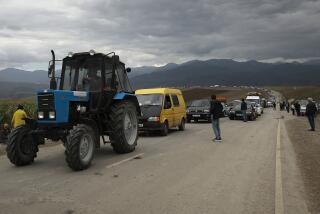A Land Divided: The Armenia/Azerbaijan Crisis : THE TROUBLED LANDS
ARMENIA
The Armenian Soviet Socialist Republic has an economy based chiefly on manufacturing, which accounts for about 75% of the goods produced there. These goods include chemicals, electronic devices, machinery, precision instruments, and textiles. Ninety percent of the republic’s 3.3 million people are Armenian, most of whom are Christian. Azerbaijanis, Russians and Kurds make up the rest of the population. The majority speak Armenian, the oldest of the literary languages currently in use in the Soviet Union. The republic covers about 11,500 square miles (about the size of the combined totals of Los Angeles and Riverside counties).
AZERBAIJAN
The Azerbaijan Republic is the largest of the three Soviet Republics in the Caucasus mountain region. Well over half of the 6.7 million people living in the 33,400 square-mile republic are Shiite Muslim. In addition to the Nagorno-Karabakh region, Azerbaijan governs the Nakhichevan autonomous republic. As home for most of the Soviet Union’s oil services industry, Azerbaijan plays a key role for that nation’s vital oil production industry. The richest oil-producing areas in the republic are along the Caspian Sea.
NAGORNO-KARABAKH
The Autonomous Region of Nagorno-Karabakh covers only 1,700 square miles of rugged hills, mountains and deep ravines. Its size (comparatively, a little smaller than Ventura County) represents only 5% of Azerbaijan’s territory. The 170,000 population is 75% Armenians, the rest mainly Azerbaijani. The Armenians of this enclave consider themselves part of historic Armenia, despite the fact that the region does not border on Armenia (it is separated by six miles at the closest point.). Soviet power was established in Armenia and Azerbaijan in 1920 but the status of Nagorno-Karabakh remained in flux until 1923, when it was awarded to Azerbaijan as an autonomous region. Many Soviet historians today admit this may have been a mistake.
More to Read
Sign up for Essential California
The most important California stories and recommendations in your inbox every morning.
You may occasionally receive promotional content from the Los Angeles Times.










